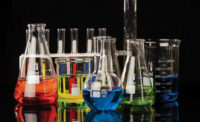Focus On: One Supplier to the Adhesives and Sealants Industry is Finding Diamonds in the Rough
New product ideas are just waiting to be discovered.

The next time you’re in a car, take a close look at the many different materials inside and outside that are bonded together. As automakers use increasingly

|
lighter and more diverse material options to reduce vehicle weight and improve fuel efficiency, they will need new adhesive chemistry that combines multiple materials. Adhesives could help automakers reduce or even completely replace traditionally used rivets and welds, providing a practical lightweighting option along the way.
Finding an unnoticed and/or under-explored market opportunity such as this is at the core of Bayer MaterialScience’s innovation process. Known internally as the “Diamond Process,” it is a comprehensive methodology to mine market needs and opportunities to develop material solutions. Based on the Stage-Gate®* idea-to-launch process, the Diamond Process is a collection of tools and techniques Bayer has combined and customized to better understand and identify market needs.
*Stage-Gate Process® is a registered trademark of Stage Gate Inc.
Innovative Spirit, Comprehensive Product Development
The innovative spirit at Bayer MaterialScience dates to Otto Bayer’s discovery of polyurethane chemistry in 1937. At the time of the discovery, Bayer knew he had found a completely new chemistry and was able to successfully market it. Interestingly, many of the applications for polyurethane chemistry that he envisioned have become commercialized, including polyurethane foams, adhesives and coatings.
A focus on finding and solving business and market problems with sustainable products is at the heart of Bayer’s innovation process today. The conventional process of developing a new application was viewed as only a research and development (R&D) effort. The Diamond Process goes beyond R&D in the lab—it includes ideation, recognition of a market need, exploration and identification of market opportunities, making a business case, pursuing technical development, understanding the impact of a new product to the supply and manufacturing chains, and bringing a product to market. These steps are broken into manageable stages for teams of 2-5 people. The steps are as follows:
• Stage one uses tools and techniques to uncover market insights. These include listening events, such as customer interviews, as well as secondary market research.
• Stage two is a deep dive into the business case of an opportunity, with a heavy focus on marketing and value proposition.
• Stage three focuses on technical development in the lab to create a material solution.
• Stage four involves commercial preparation, including promotion, manufacturing and scaling up the technology.
• Stage five is the execution of the product launch.
Bayer’s innovation process creates an interconnectedness that is supported by a cross-functional team focused on the next step. Previously, for instance, R&D may have been tasked to solve a technical problem. Then they would hand it off to manufacturing colleagues to figure out how to produce it. Compare that to the Diamond Process, where every stage and team member is thinking about the next step and how this product idea will impact it. In addition, the teams are drawn from different parts of the business, such as Sales, Marketing, Manufacturing and Technical departments.
Open innovation comes into play throughout the process and as teams look for new or adjacent markets and ask for insight outside of their expertise. One example is Bayer’s “Dream Production” project, which uses carbon dioxide as a basic building block for manufacturing plastics. Using a certain amount of CO2 as a building block enables a reduction in the amount of the petroleum-based raw material propylene oxide from which polyols are normally entirely made. It also turns a waste gas into a useful raw material. Bayer developed the manufacturing process in collaboration with partners in industry and academia. The company discovered the catalyst that brings about the chemical reaction with the required level of efficiency, and developed it together with the CAT Catalytic Center, a research facility in Aachen, Germany.
Following a successful test phase and promising market analysis, Bayer plans to invest roughly $20.5 million (€15 million) in the construction of a production line at its Dormagen site, which will use CO2 to produce a precursor for premium polyurethane foam. The objective is to launch the first CO2-based polyols in the market starting in 2016.
Emphasis on Material Lifecycle
Sustainable innovation is an important influence. In fact, the focus on sustainability is driving significant innovation within Bayer to reduce a product’s impact on the environment and lessen the carbon footprint. Bayer uses a lifecycle analysis, which is a holistic evaluation of the environmental impacts from all stages of a product’s life, from raw material acquisition to end-of-life, according to ISO 14040/44.
A recently published case study* illustrates this idea in practice. In this case, application of a polyurethane sealant in a 1955 Colonial home in the Pittsburgh area reduced airflow by 25% based on before and after blower door testing. The study also indicated estimated greenhouse gas emissions avoidance during a 10-year period equivalent to 32 acres of U.S. forest, and approximately 10 times the amount of energy savings per year compared with the amount of energy embodied in the sealant.
More than just a mathematical exercise, customers are increasingly seeking this information for materials, and consumers are becoming more interested in learning how the lifecycle of products they purchase impact the environment.
* “Case Study: Polyurethane Sealants Lead to Energy Savings,” ASI March 2014, www.adhesivesmag.com/articles/92689-case-study-polyurethane-sealants-lead-to-energy-savings.
Innovating Adhesives for Vehicles
The Diamond Process also is creating tangible benefits and opportunities for Bayer’s Coatings, Adhesives and Specialties business. For example, take a key growth area: the automotive market. To learn more about unmet automotive adhesive market needs, Bayer used the innovation process, beginning with listening events. The insight that kept resurfacing was that joining mixed materials is a significant challenge for automakers as they use new material combinations to help reduce vehicle weight. One person said during the industry conversations that “to achieve 2025 CAFE Standards, we need robust bonding systems that provide design flexibility, which will ultimately help us make cars people want to buy.”
Key steps along the way included segmenting the market, examining the full value chain, conducting market research, talking to key industry leaders, and listening to and prioritizing the customer’s needs. Lightweight, multi-material vehicles require bonding technologies to handle a diverse material mix. By using the Diamond Process, Bayer identified the market need and developed raw materials for adhesives, such as two-component polyurethane adhesives, that are well-suited for this task. In addition, Bayer is continuing to research adhesives to better bond lighter-weight substrates.
Developing Optically Clear Polyurethanes for LEDs
Lighting is another market undergoing significant change. Because of its sustainability, LED lighting is gaining popularity in living rooms and offices, as well as cars. As lighting engineers and designers re-imagine energy-efficient lighting to meet this demand, they are looking for high-performance and cost-effective material solutions.
During industry conversations and market research, Bayer identified that one need was a crystal clear protective layer to place on an LED lens. The protective layer needed to provide low-temperature curing, pressure-less application, scratch resistance, weather resistance, high transparency, customizable flexibility and hardness properties, and high impact resistance.
Using this insight, the team determined that aliphatic polyurethane chemistry would be a good fit for this potential application. Bayer’s portfolio includes a lightfast polyurethane cast system that can encapsulate LEDs. The solvent-free chemistry provides bubble-free application by means of a simple casting process, good UV resistance, high transparency, heat resistance of up to 100°C, and adjustable hardness and flexibility.
Meeting Market Needs with Material Solutions
Distilling an innovative spirit into an actionable and accountable process that uncovers unmet market demands and needs is not an easy endeavor. The use of a comprehensive innovation process to identify diamonds in the rough for new product ideas can help simplify the challenge and lead to sustainable material breakthroughs.
Bayer is leveraging all of the tools in its toolbox to better understand a market’s unmet needs and funnel that into its new product process. Through listening to customers, doing due diligence in the marketplace and then freeing team members to think outside the box, Bayer is discovering new applications and technologies that continue Otto Bayer’s legacy of innovation.
For additional details, phone (412) 777-2674, fax (412) 788-6544, email jim.charron@bayer.com or visit www.materialscience.bayer.us.
Looking for a reprint of this article?
From high-res PDFs to custom plaques, order your copy today!





